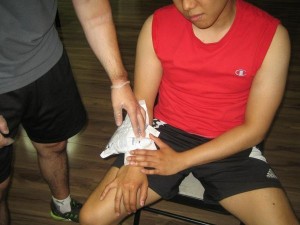Cat and dog bites are quite common and can be caused by a family pet or a neighborhood stray. There are considerations to bear in mind on how to take care of cat and dog bites. In cases that you find difficult to manage, it is best to consult a doctor. Just to be prepared, you can enroll in a first aid course so that you can learn the appropriate measures to perform.
- Wash the bite site in a gentle manner using water and soap.
- Apply pressure using a clean cloth or towel over the wound to stop the bleeding.
- You have to place a sterile bandage on the wound.
- You have to keep the bite site elevated higher than the heart to reduce the inflammation and prevent any signs and symptoms of infection from developing.
- Apply an antibiotic ointment on the area 2 times in a day until it heals.
If needed, you have to report the incident to the animal control office or the police.

What will the doctor do?
There are some cases of cat and dog bites that must be assessed and treated by a doctor. The doctor will perform the following:
- Check the wound for possible damage to the tendon, bone or nerves as well as signs of infection.
- Clean the bite site using a special solution and remove any damaged tissue
- Apply stitches to close the wound to reduce the risk for infection, but often the wound is left open to heal.
- Prescribe an antibiotic to prevent infection from developing
- Administer a tetanus shot if the individual had his/her last shot more than 5 years ago.
- Schedule a follow-up appointment after 1-2 days
When it comes to severe cases of cat and dog bites or the infection has not subsided even after the use of antibiotics, the doctor might refer the individual to a specialist or to the hospital so that special medications can be given intravenously and further treatment is required.
When to consult a doctor
- The individual sustained a cat bite. Take note that cat bites are known to have a higher risk for developing infection.
- A dog bite in the foot, hand or head or a bite that is too deep or gaping wide open.
- Individual has diabetes, cancer, lung or liver disease, AIDS or conditions that can weaken the ability of the body to fight infection.
- There are signs of infection such as swelling, redness, warmth, drainage of pus and increased tenderness from the wound or a fever.
- Bitten by a wild animal or domestic animal with an unknown vaccination status
- Bleeding that does not stop after 15 minutes of pressure or you suspect that there is a broken bone, damage to the nerves or another serious injury
- The last tetanus shot received by the individual was more than 5 years ago.
It is important to note that cat and dog bites can be prevented. If you have a pet, do not leave young children alone with them. When animals such as dogs or cats are fighting, do not attempt to separate them since you might get bit in the process. Always keep the vaccinations of your pets updated.
